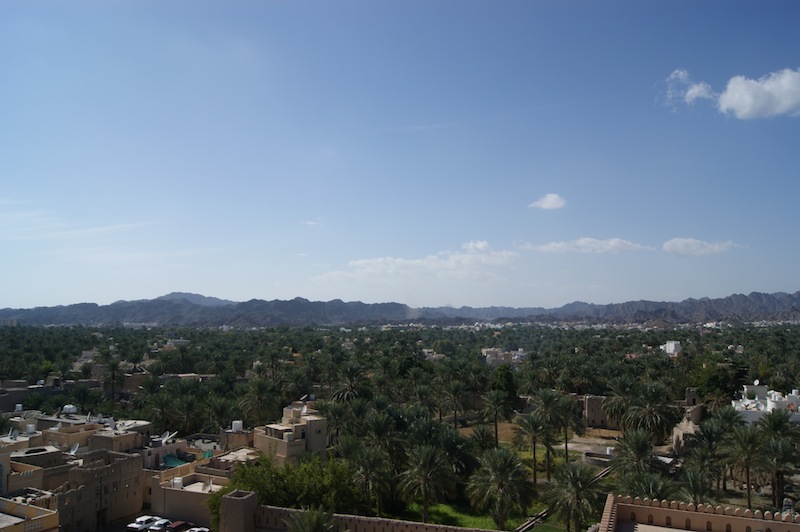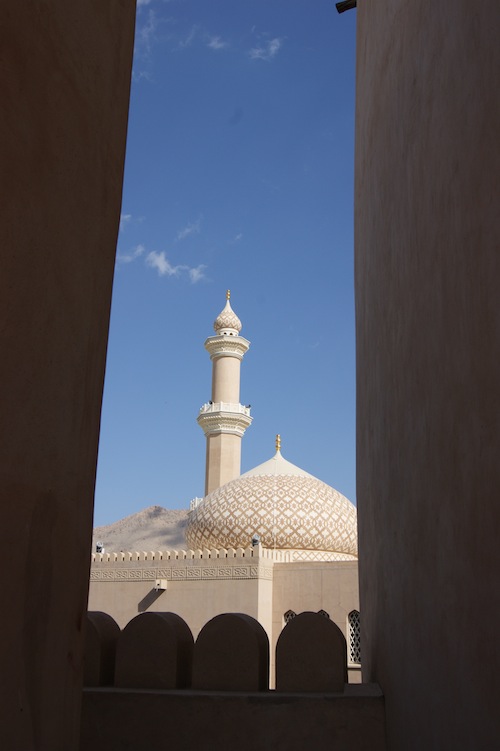A few decades ago the town of Nizwa was off-limits, a focus of rebellion and violence. But now it’s a popular day trip for visitors to Oman, and its main attraction is a 17th century fort.
So it had to be on the itinerary of our trip to the country despite my lack of driving experience and nervousness at tackling Arabian roads. It took us about two hours to get there from our base in the capital, Muscat, but it was a journey memorable for its impressive landscapes of arid mountains in reds and browns, rusts and greys. Jagged and ancient, they were broken by wadis, flood plains and dusty villages.

Some of the villages and hamlets were pretty remote and I wondered how the residents could make a living so far from anywhere. After all, the land around and about didn’t look much like productive agricultural country. However, miles from Muscat, the locals took pride in their homes, which looked neat and tidy, well-tended and freshly painted.
We had a few dodgy moments thanks to confusing road signs, the lack of petrol stations and a few reckless drivers with no concept of speed limits, but arrived in Nizwa bathed in sunshine still in one piece and with a full tank. We parked up in front of the atmospheric, castle-like souk, in a giant, unattractive car park.

Around us were streets of typical Omani apartment blocks, shops and eateries, some modern, some shabby, many displaying the garish neon signs that are a sure sign that you’re in the Arab world. Feeling hungry, we found a cheap place for a quick kebab, which looked a bit dodgy but didn’t poison us.
The fort is an impressive sight, an explosion of terracotta colours, one of Oman’s most famous attractions thanks in part to its monumental round watchtower. A key defensive structure for many centuries, it was built to protect the vital communication routes that ran – and continue to run – through the region.
It was sweltering as we made our way round and sweatily climbed the 30 metre-high tower for views of the town beyond, ringed by red, yellow and grey mountains and vast plantations of date palms, all of which lay beneath a rich blue sky.

The tower is just one part of the fort, which has a maze of buildings and rooms, some with displays that tell its story. It’s thought that there’s been a fort of one kind or another on the site since the 12th century but much of what stands today – a truly formidable fortress – dates mainly from the 1650s. Much has been heavily restored but the work has been carried out sympathetically.
The popularity of tourism in Nizwa is perhaps surprising. It was only about 40 or so years ago that the rebellious local imams who’d fought for decades against central rule were finally brought under control, allowing a part of the country that had been off-limits to visitors to be opened up by the new Sultan.

We left for a short walk around the town, occasionally finding ancient city walls and crumbling historic buildings amid the newer development. Sadly, the souk was deathly quiet, the traders having taken a few hours off from making a living because of the afternoon heat.
So we drove on to the Al-Hoota Cave through increasingly grey and black mountains dotted with the centuries-old watchtowers that can be seen throughout Oman. The scenery was amazing, and we stopped to take photos, but we got all the way to the cave only to find it shut for maintenance.
So we drove home instead and encountered one of the most torrential downpours I’ve ever seen. With the sun going down and rain lashing the windscreen, it was impossible to see anything and we crawled back into Muscat on the dual carriageways in a state of some alarm and at little more than crawling pace. So disorientated was I that at one point we ended up driving around a multi-storey car park rather than down the motorway back to the city.
The landscapes that had been such a highlight of our day disappeared in the gloom…

